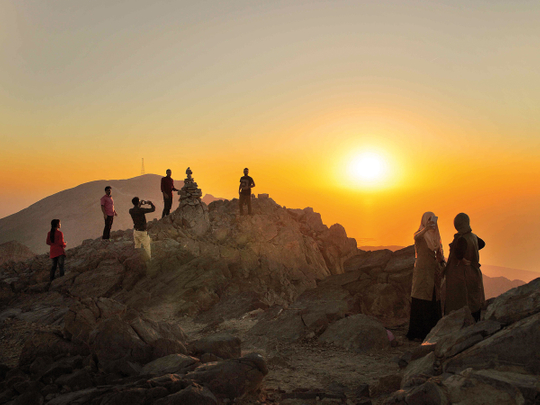
Hatta
Why it’s special Drive north all the way to this UAE exclave high in the Hajar mountains for scenery that will delight nature lovers and budding photographers alike. This is the perfect spot to run away from busy city life and enjoy a quiet day taking in the country’s nature and arguably most spectacular views. With massive mountains and natural pools of crystalline waters, this road trip is picture perfect. If you want to turn this trip into a mini break, book a stay at the recently refurbished JA Hatta Fort Hotel and soak in the amazing views from your balcony.
Jebel Jais
Why it’s special Jebel Jais in Ras Al Khaimah is the UAE’s highest mountain and rises 1,934 metres above sea level. The trip there from Dubai or Abu Dhabi is ideal for sporty types who want to strap their trusty bikes to the roof as the location offers some amazing mountain trails. The route itself takes in the rugged Hajar mountains, and with the newly-built 30km road heading towards the peak this road trip offers a wonderfully scenic driving experience offering excursions through deep canyons, mighty boulders and ancient villages. Top tip: don’t miss the cool new viewing deck at the summit.
Jebel Hafeet
Why it’s special The drive to the UAE’s second highest peak, Jebel Hafeet mountain, is definitely one for car enthusiasts thanks to a sturdy climb that rises 1,240 metres and mysterious million-year-old limestone landscapes. Once you navigate the winding, isolated road you are rewarded with spectacular views of the adjacent desert, Oman, and of the garden city of Al Ain. Fun fact: This immaculate road was built by Strabag International of Germany and with three lanes and 60 turns it is considered one of the best driving roads in the world.
Liwa Oasis
Why it’s special For a trip that is truly other-worldly, drive out into the vast, orange Liwa desert (SUV advised) and head to the beautiful Liwa Oasis. Located in the south-eastern part of the UAE and very close to the Saudi Arabian border, the oasis is situated on the north-eastern edge of the Empty Quarter. With more than 50 different villages, this is the historical home of the royal Nahyan family and remains to this day a date palm cultivating region for Bedouin tribes. While there you can spend a night in one of a handful of secluded hotels, such as the pretty Tilal Liwa set right at the edge of the desert.
Musandam Peninsula
Why it’s special The stunning Musandam Peninsula is actually an exclave of Oman but is separated from it by the UAE. If you drive directly from Dubai, you could reach the border in around two hours depending on traffic, but better to take things easy with leisurely coffee breaks. Once you pass the Oman border — don’t forget your passport! — head to Khasab, the Musandam Peninsula’s main town. This 40km or so route skirts the beautiful coastline, hugging the Hajjar Mountains the whole way. Khasab is the departure point for some lovely excursions offered by local tour operators, so it’s worth parking up and hopping on a traditional dhow for a breathtaking Musandam cruise in an area often described as the Norway of Arabia.
The road to Fujairah
Why it’s special If you’re new to the UAE, Fujairah is sure to surprise with its vast mountain ranges, green oases and incredible scuba diving opportunities. The road trip from Abu Dhabi or Dubai should be done unrushed to take in the dunes that get gradually more orange as you drive along, not to mention the blissful peace and quiet. The roads en route are ultra smooth and there are several hotels and eateries along the way. Don’t miss the Friday market (humorously open every day) on the Dubai side of Masafi set along the road itself, stocked with natural produce and manned by friendly sellers. The city centre of Fujairah is well worth a traipse around too, with quaint restaurants and shops and a friendly vibe.












